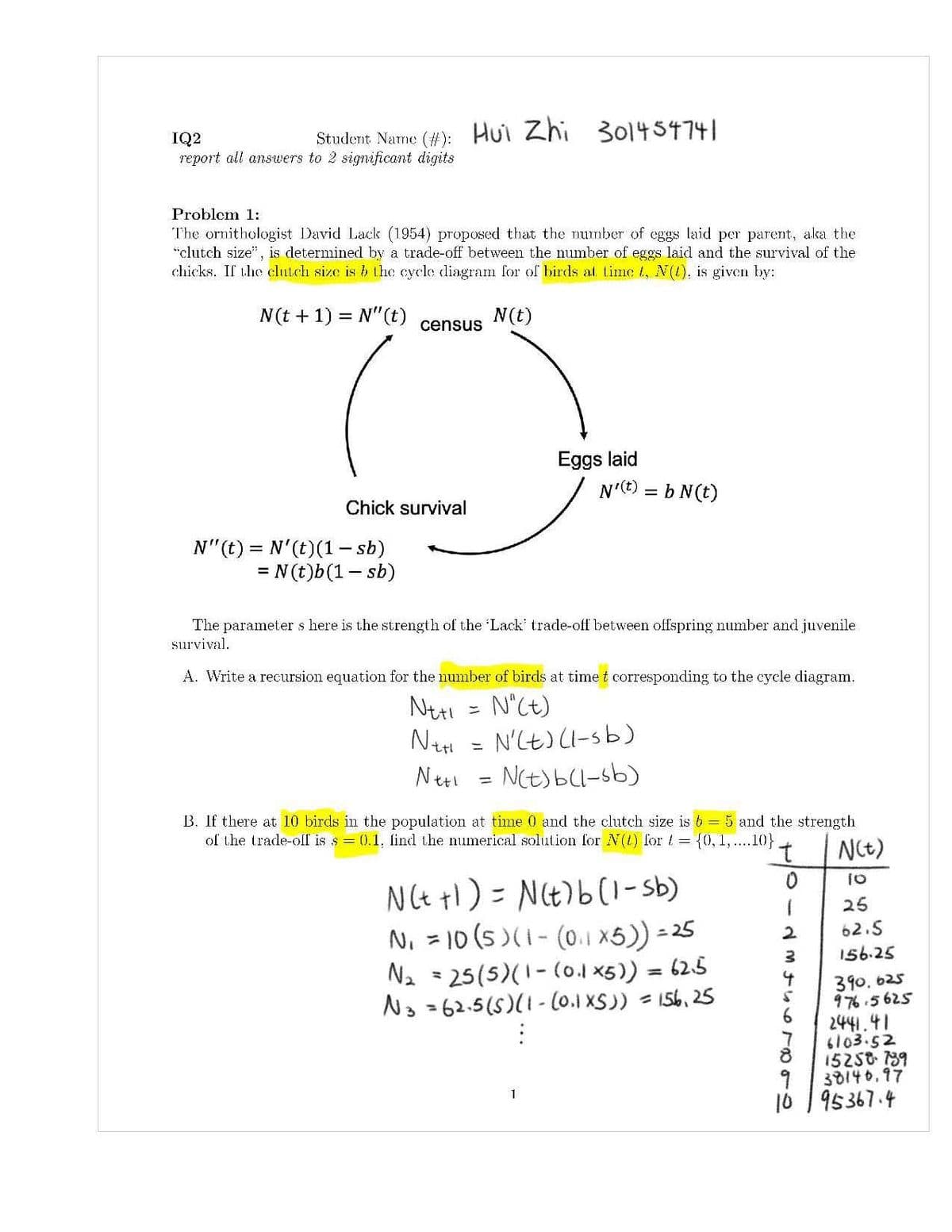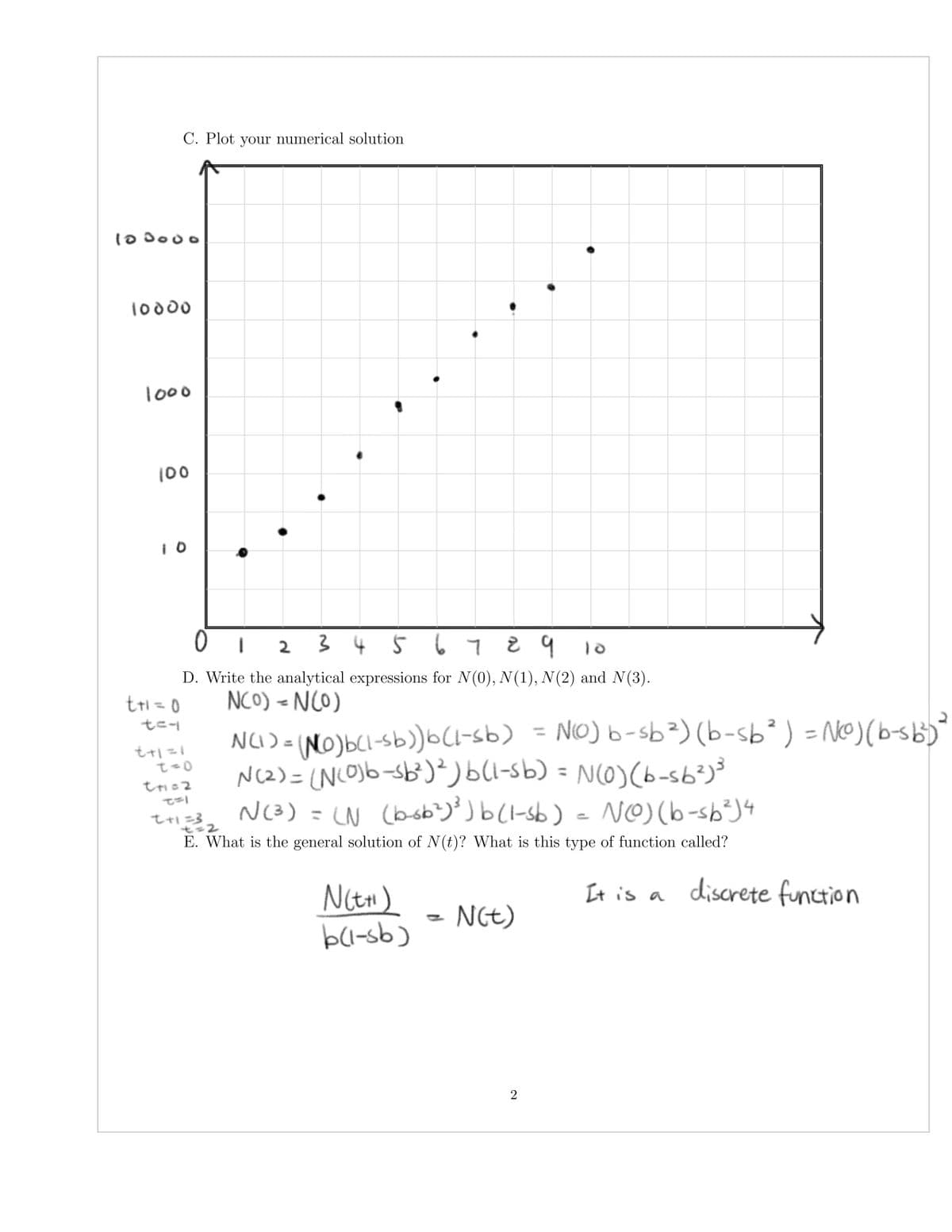Problem 1: The ornithologist David Lack (1954) proposed that the number of eggs laid per parent, aka the "clutch size", is determined by a trade-off between the number of eggs laid and the survival of the chicks. If the clutch size is b the cycle diagram for of birds at time 4, N(1), is given by: N(t + 1) = N"(t) N(t) census Eggs laid N't) = b N(t) Chick survival N"(t) = N'(t)(1- sb) = N (t)b(1- sb) The parameter s here is the strength of the Lack' trade-off between offspring number and juvenile survival. A. Write a recursion equation for the number of birds at time t corresponding to the cycle diagram. N°Ct) is N'(t) (I-sb) %3D NtSb(I-sb) %3D B. If there at 10 birds in the population at time 0 and the clutch size is 6 5 and the strength of the trade-olf is s = 0.1, find the numerical solution for N() for {0, 1,..10} NCt) Nt t1) = Nt)b(1- sb) N, = 10 (s )(1- (0.1 ×5)) = 25 Na = 25(5)(1- (o.1 x5)) = 625 N3 =62.5(S)(1- (0.1 XS)) = 156, 25 10 25 62.5 %3D 156.25 %3D 3१०. ०25 976 5625 2441.41 6103.52 15258 789 30140,97 1 10 1 95367.4
Problem 1: The ornithologist David Lack (1954) proposed that the number of eggs laid per parent, aka the "clutch size", is determined by a trade-off between the number of eggs laid and the survival of the chicks. If the clutch size is b the cycle diagram for of birds at time 4, N(1), is given by: N(t + 1) = N"(t) N(t) census Eggs laid N't) = b N(t) Chick survival N"(t) = N'(t)(1- sb) = N (t)b(1- sb) The parameter s here is the strength of the Lack' trade-off between offspring number and juvenile survival. A. Write a recursion equation for the number of birds at time t corresponding to the cycle diagram. N°Ct) is N'(t) (I-sb) %3D NtSb(I-sb) %3D B. If there at 10 birds in the population at time 0 and the clutch size is 6 5 and the strength of the trade-olf is s = 0.1, find the numerical solution for N() for {0, 1,..10} NCt) Nt t1) = Nt)b(1- sb) N, = 10 (s )(1- (0.1 ×5)) = 25 Na = 25(5)(1- (o.1 x5)) = 625 N3 =62.5(S)(1- (0.1 XS)) = 156, 25 10 25 62.5 %3D 156.25 %3D 3१०. ०25 976 5625 2441.41 6103.52 15258 789 30140,97 1 10 1 95367.4
Algebra & Trigonometry with Analytic Geometry
13th Edition
ISBN:9781133382119
Author:Swokowski
Publisher:Swokowski
Chapter5: Inverse, Exponential, And Logarithmic Functions
Section5.6: Exponential And Logarithmic Equations
Problem 69E
Related questions
Question
Could someone please check if I'm doing these right?

Transcribed Image Text:IQ2
report all ansuwers to 2 significant digits
Student Narme (#): Hui Zhi 301454741
Problem 1:
The ornithologist David Lack (1954) proposed that the number of eggs laid per parent, aka the
"clutch size", is determined by a trade-off between the number of eggs laid and the survival of the
chicks. If the clnteh size is b the cycle diagram for of birds at time 1, N(1), is given by:
N(t + 1) = N"(t)
N(t)
census
Eggs laid
N'e) = b N(t)
Chick survival
N"(t) = N'(t)(1- sb)
= N (t)b(1- sb)
The parameter s here is the strength of the 'Lack' trade-off between offspring number and juvenile
survival.
A. Write a recursion equation for the number of birds at time t corresponding to the cycle diagram.
N°Ct)
NH = N'Lt)(I-sb)
NtSbl-sb)
B. If there at 10 birds in the population at time 0 and the clutch size is 6 = 5 and the strength
of the trade-off is s = 0.1, find the numerical solution for N(t) for = {0, 1, ....10}.
NCt)
NCt tl) = Nt)6(1-sb)
N, = 10 (s)(1- (o.1 x5)) = 25
Na = 25(5)(1-(o.1 x5)) = 62.5
No =62.5(5)(1- (0.1 XS)) = 156,25
10
25
2
62.5
%3D
156.25
%3D
390. 625
976.5625
2441.41
6103.52
15258 739
30140,97
1
10 1 95367.4
ナueトの

Transcribed Image Text:C. Plot your numerical solution
10D000
1000
1000
00
234 5 6729
10
D. Write the analytical expressions for N(0), N(1), N(2) and N(3).
NCO) =NCO)
tri =D0
tニ
NI)=(NO)b(1-Sb))-sb)
N(2)= (NCO)b-sb )²)b(1-sb) = N(0)6-s6?)3
NC3) = LN (bsb)³ )b(I-sb) = NO)(b-sb²)4
N) =(NO)bCl-sb))6(1-sb) = NO)6-sb²)(b-sb²) = NO)(b-sb
もti
%3D
しie2
tt多。
%3D
E. What is the general solution of N(t)? What is this type of function called?
It is a discrete function
NGt)
bl-sb)
2
Expert Solution
This question has been solved!
Explore an expertly crafted, step-by-step solution for a thorough understanding of key concepts.
This is a popular solution!
Trending now
This is a popular solution!
Step by step
Solved in 6 steps with 1 images

Recommended textbooks for you

Algebra & Trigonometry with Analytic Geometry
Algebra
ISBN:
9781133382119
Author:
Swokowski
Publisher:
Cengage

Algebra & Trigonometry with Analytic Geometry
Algebra
ISBN:
9781133382119
Author:
Swokowski
Publisher:
Cengage